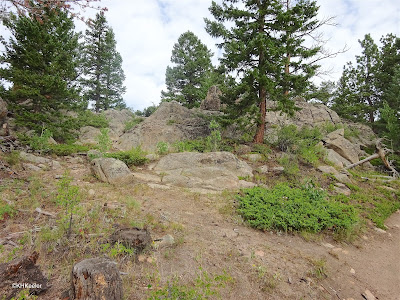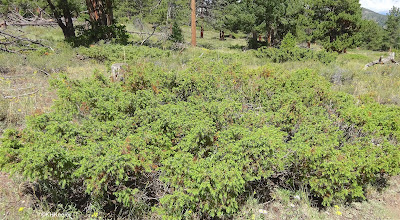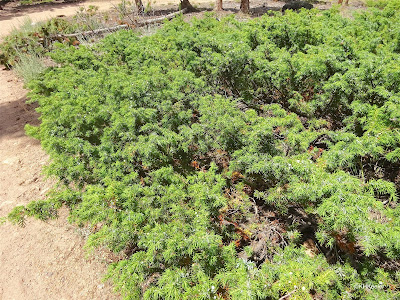The prostrate juniper is, as the name says, a juniper that runs along the ground, like a ground cover, and does not stand tall like a tree. North America has two such junipers, the prostrate juniper, Juniperus communis variety depressa and the creeping juniper, Juniperus horizontalis. Both are native, but prostrate juniper is more widespread, found over most of the continent (map). The common juniper, Juniperus communis, is the most widespread woody plant in the world, growing across Eurasia as well as North America. With a range that big, it is very variable and seven distinctive varieties are recognized. In Eurasia it is mostly an upright tree, though one variety, J. communis var. saxatilis, is prostrate. There is no close relationship between the two prostrate forms and J. communis var. depressa colonized all of North America.
 |
| the low flat green plant is prostrate juniper Juniperus communis var. depressa |
These are dioecious shrubs, like other junipers. Some plants produce only pollen, others only ovule-containing cones that become the soft edible "berries." Berry is used in botany for fruits of flowering plants, and not for conifers like the junipers which develop their seeds in cones ("fruit" is what totally encloses the seeds of flowering plant, "cones" only partly enclose the seeds of conifers), but berry is a widespread common name for the fleshy female cones of junipers. In having fleshy cones, junipers differ from most other conifers. Worldwide, the common juniper, with ancestors in dry habitats, quickly invaded the far north as the last glaciers retreated. Juniper berry-eating birds are given credit for propelling that movement. The prostrate juniper's range includes the high Arctic and high mountains, much colder habitats than those of most of the 70 or so other juniper species. A prostrate form is important and effective for growing in tundra, where, as the soil freezes and thaws, it uproots trees.
 |
| Fleshy cones on prostrate juniper |
The fleshy cones develop slowly, taking three years to mature. They increase steadily in size and turn blue-black when ripe. Rich in vitamin C, they also contain thujone, which can make them quite bitter. The common juniper of Europe, Juniperus communis var. communis, is the plant whose berries (I decided "fleshy cones" was too cumbersome) were fermented to produce gin. They were also used widely as a spice, in dishes from stews to sauerkraut. The thujone in the berries will cause an upset stomach, diarrhea, and ultimately kidney problems if consumed in substantial quantities. Juniper species vary greatly in how much thujone is in their berries, to the point that some juniper berries are considered poisonous (berries of Juniperus sabina, savin, of southern Europe, for example). The common juniper is among the least toxic and considered safe for human consumption. If gathering juniper berries, be sure you know what species you have. Even if it is the common juniper, because the species is very variable, if it doesn't taste good, don't eat it.
 |
| prostrate juniper |
A wide variety of North American (and probably Eurasian) wildlife eat the leaves and berries, from deer and moose to mice to game birds, although livestock don't like it. It is an important source of winter forage for native animals.
People have used common juniper as a medicine all over the world for millennia. Both in North America and Europe, juniper branches were used to make steam to treat chest and sinus congestion. All across North America, tribes boiled leaves, roots, and berries into a drink for stomach pain and heartburn. They also used it to treat ailments from eye trouble to gynecological problems; it was a major medicine. European usage was strikingly similar. Modern studies of common juniper have found it to have great potential as an anti-inflammatry, diuretic, and for dyspepsia, but medical websites stress the need for more testing in humans (See links in references).
The fragrance is commonly used in products, from candles to bath oils. Prostrate juniper rarely makes big enough pieces of wood for much construction beyond spoons and small boxes, but the wood is attractive, sturdy and has a pleasant smell.
Some Native Americans considered it lucky; the Kitasoo rubbed it on and the Ramah Navajo burned it for good luck.
In Europe, common juniper berries were widely used to induce abortions and a variety of folk stories allude to that, calling it, for example, bastard killer. That is the savin tree reference in the classical ballad Mary Hamilton (version 173D.4 link)
She’s gane to the garden gay
To pu of the savin tree;
But for a’ that she could say or do,
The babie it would not die.
(My sources clearly said this referred to Juniperus communis, but the name savin was also used for the southern European Juniperus sabina, which is not considered safe to eat. I think only J. communis grows in England, not J. sabina.)
Another, seemingly contradictory, theme in European folklore was of common juniper as the protector, guarding against witches, sickness, and attacks by wild animals. You burned it for protective smoke, tied it on or hung it by the house's doors and windows to ward off evil.
 |
Comments and corrections welcome.
References
Adams, R. P. and R. N. Pandey. 2003. Analysis of Juniperus communis and its varieties based on DNA fingerprinting. Biochemical Systematics and Ecology. 31: 1271-1278.
Adams, R. P., R. N. Pandey, J.W. Levering, N. Dignard, K. Hoegh, and T. Thorfinnsson. 2003. Pan-Arctic variation in Juniperus communis: historical biogeography based on DNA fingerprinting. Biochemical Systematics and Ecology. 31:181-192.
Cunningham, S. 1985. Cunningham's Encyclopedia of Magical Herbs. Llewellyn Publications, St. Paul, Minnesota.
Knyazeva, S. G. and E. V. Hantemirova. 2020. Comparative analysis of genetic and morphs-anatomical variability of common juniper (Juniperus communis L.) Russion Journal of Genetics. 56 (1); 48-58.
Radford, E. and M Radford. 1961. Encyclopaedia of Superstitions. C. Hole, editor. Hutchinson, London.
Van Diersal, W.R.1938, Native Woody Plants of the United States, . Their Erosion-Control and Wildlife Values. United States Government Printing Office, Washington D.C.
Vickery, R. 1995. Oxford Dictionary of Plant-Lore. Oxford University Press, Oxford, England.
Medical uses, see for example:
Moerman, D. E. 1998. Native American Ethnobotany. Timber Press, Portland, OR. Online: link
WebMD Juniper link Accessed 10/25/2020
Kathy Keeler, A Wandering Botanist
More at awanderingbotanist.com
Join me on Facebook: https://www.facebook.com/AWanderingBotanist

every post you write is interesting. what a great blog!
ReplyDeleteLovely. Enjoyed this, thank you!
ReplyDeleteBirds love it. Great details for birdwatchers
ReplyDelete